Cochabamba and Huayculli
8 December, 2007, 08:26 pm in "Bolivia"
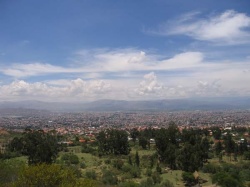 Cochabamba reminds me of someplace--or maybe a combination of places. Sometimes New Orleans, sometimes Chiang Mai, sometimes some other places but I'm not sure where. It is a comfortable, almost tropical place and though they call it the city of eternal summer, it makes me think of spring. It is a pleasant place, not for an abundance of tourist sites but rather just as a place to hang out. It is nice to wander around. There is a lot of street life. I guess due to the weather, everything can be done outside, so it is. According to Wikipedia, is the largest open air market in South America. We also found the largest market devoted solely to bananas that we've ever seen.
Cochabamba reminds me of someplace--or maybe a combination of places. Sometimes New Orleans, sometimes Chiang Mai, sometimes some other places but I'm not sure where. It is a comfortable, almost tropical place and though they call it the city of eternal summer, it makes me think of spring. It is a pleasant place, not for an abundance of tourist sites but rather just as a place to hang out. It is nice to wander around. There is a lot of street life. I guess due to the weather, everything can be done outside, so it is. According to Wikipedia, is the largest open air market in South America. We also found the largest market devoted solely to bananas that we've ever seen. 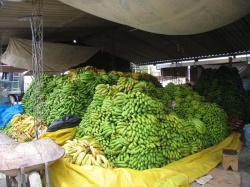
The parks are full of people and so are the sidewalks. The city has nice colonial buildings as well as a pretty natural setting. To the North, you can see snow capped mountains and to the East, cactus covered hills.
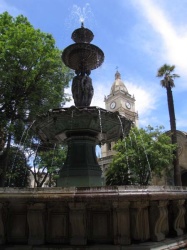
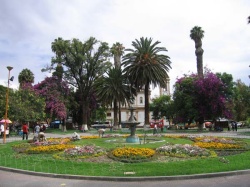
We ate breakfast on a street corner and then walked to a botanical garden, arriving just in time for a siesta. It wasn't a pristine, well-groomed palace garden but rather a slightly wild garden which invited people to sit on the grass and listen to the large number of birds singing in the trees.
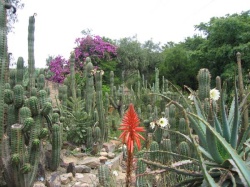
Guys from a colegio were playing a game Rowshan recognized from Iran and Turkey, "Long Donkey," where 1 team leap frogged onto the backs of the other team and tried to make the "donkey" team collapse. Rowshan asked the players the name of the game which was (ChoroMoro).
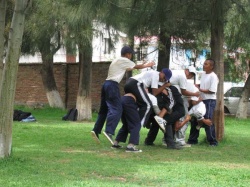
After walking around the garden (and napping on a bench), we headed north of the river. It looked like a swanky region with fancy restaurants, bars and clubs. We went to a cultural center (with a more groomed palace garden) to see an interesting art exhibition of contemporary artists.
While walking back to the center, we noticed bunches of buses had been parked to block the main streets. I heard Bolivians were always protesting so I figured this was another transportation strike. The next day there was a huge protest march about the new Bolivian constitution. A lot of businesses were closed. We even saw what we thought was a donkey protest which we figured was due to the exclusion of donkeys from La Cancha market.
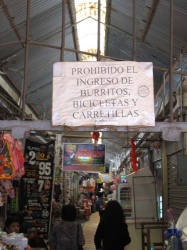
It turned out to be just a group of donkeys on their way to hassle drivers who stopped in the crosswalks.
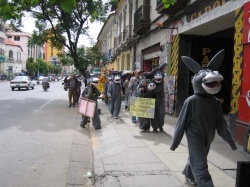
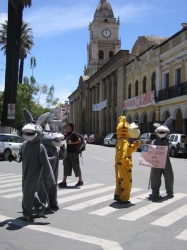
Cochabamba Traffic Donkeys
In the plaza, there is an information board (sponsored by a political organization) and all day Friday, there seemed to be a heated political discussion going on next to it. (Later, we learned we are in Bolivia at a very heated political time with a controversial new constitution, and a push for moving the capital back to Sucre.)
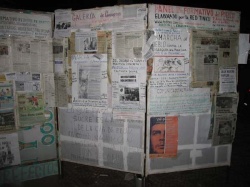
On Thursday, we hiked up a hill overlooking the town. Rowshan decided to return to town and go visit a ceramics village while I finished the hike.
I (Rowshan) had a map with ceramic pictures on it which I had taken from the information office. I took a shared taxi to Tarata which was about 35 KM south of Cochabamba. The actual village where they do ceramics was Huayculli 8 KM east of Tarata. Since the scenery was beautiful, I decided to walk.
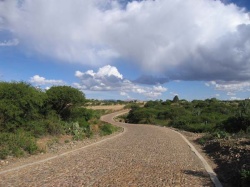
During walking I saw broken pots which was a sign that I was on a right track. When I saw the piggy banks, I was sure that I would see the ceramic village.
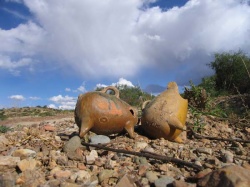
I asked three kids sitting next to the road about the village and they said that I was there. The strange thing was that there were only a few people in the village and the plaza was completly empty.
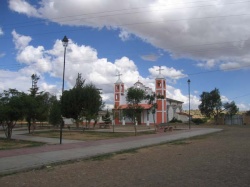
I saw a family and asked them where I can find ceramics and see how they make pots. The told me that all the people were at a fiesta and nobody was working that day which I had realized. Any way, since I had walked 8 KM, I did not want to give up.
Almost all the houses had kilns in their yards with raw clays in another corner.
I saw a young guy in one of the ceramic houses. I said "Buenas tardes" and the guy came to me and asked what I was looking for. I explained that I was also a potter and would like to get some information about how ceramics are made there. Irvine (name of the person) walked me inside showed the kilns and answered all my questions.
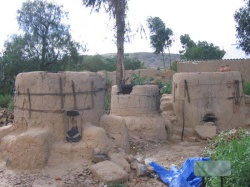
He said that all the family members do ceramics. For firing they use eucalyptus leaves in a mud made kiln. They use kick wheels (with broken parts) and molds for making their pots.
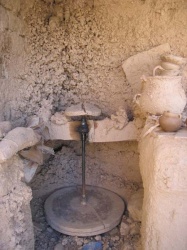
While I was walking back, I saw black smoke coming from a kiln in another house. I walked there in order to take a few photos. However, when I asked they did not allow me since I was not going to buy anything. I found another house where a man was kicking the wheel with lots of clay on it. I told him that because of travelling, I could not buy anything but I offered him some money and he allowed me to take photos and also use the video camera. Morales was very fast and in 2 minutes he had finished two bowls.
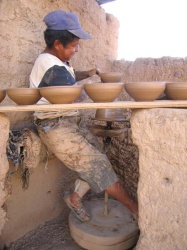
In Cochabamba the dishes and vases of Huayculli village can be seen everywhere.
In the evening there was a free concert featuring the municipal brass band and Llajtaymanta, a traditional Bolivian band which mixed panpipes, close harmonic singing and charango with pop influences.
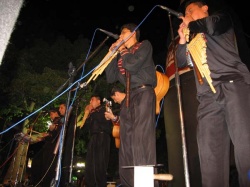
I enjoyed their South American take on "The Lion Sleeps Tonight". Everyone seemed to be having a great time. I had to admire the ingenuity of a kid who transformed his sweatshirt and the bars under the stage into a swing.
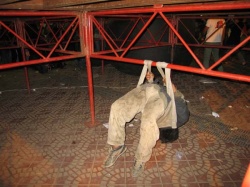
Lots of people sang along and the children danced.
Comments
- Comments
Powered by My Blog 1.69. Copyright 2003-2006 FuzzyMonkey.net.
Created by the scripting wizards at FuzzyMonkey.net..
(Code modified by Rowshan Dowlatabadi)
Created by the scripting wizards at FuzzyMonkey.net..
(Code modified by Rowshan Dowlatabadi)

